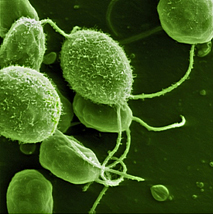Washington, DC, USA
May 27, 2014

ARS plant physiologist Autar Mattoo and his colleagues recently launched samples of a green algae Chlamydomonas reinhardtii (top) into space on board a Russian-made Soyuz space (bottom) capsule as part of an international effort to study the photosynthetic machinery of crops. Photo courtesy of Dartmouth College
By sending algae into space, a U.S. Department of Agriculture (USDA) scientist and his cooperators will be able to study some of the key mechanisms that control plant growth and photosynthesis.
The work by plant physiologist Autar Mattoo with USDA's Agricultural Research Service (ARS) is part of an international effort, largely funded by the European Space Agency, to improve the photosynthetic machinery of crops so they produce higher yields and grow in extreme environments. Mattoo works at the ARS Sustainable Agricultural Systems Laboratory in Beltsville, Maryland.
ARS is USDA's principal intramural scientific research agency, and this research supports the USDA priority of promoting international food security.
During photosynthesis, a protein-pigment complex known as Photosystem II (PS II) must constantly be repaired to fix damage caused by sunlight and ultraviolet radiation. As part of that repair process, a protein known as D1 is continuously being replaced. Research has shown that mutations of the D1 protein in the PS II complex can either increase or decrease photosynthetic activity.
The researchers wanted to assess the effects of microgravity, cosmic rays, high-energy particles and the ionizing radiation of space on the PS II complex, photosynthesis and plant growth. They also wanted to see if the effects would differ in a simple model for photosynthesis, an alga, with the D1 gene altered in specific ways.
The researchers placed samples of the alga Chlamydomonas reinhardtii in airtight "photo cells" and had them launched in a Russian-made Soyuz space capsule in Kazakhstan. The C. reinhardtii, often studied as a model for photosynthesis, spent 15 days in orbit getting doses of cosmic radiation while under light and temperature conditions that would ensure growth on earth. They also sent up four mutants of C. reinhardtii with alterations in the D1 protein gene.
They found that some aspect of the space environment inhibited the ability of the control C. reinhardtii and two of the four mutant strains to photosynthesize and grow, both in space and later when they were brought back to Earth. However, two other mutant strains flourished, both in space and when they returned to Earth. The results, published in PLOS ONE, shed new light on the importance of the D1 protein both in photosynthesis and as a target of environmental signals.
Read more about this study in the May/June 2014 issue of Agricultural Research magazine.
Enviando las algas al espacio para investigar el funcionamiento de plantas en ambientes extremos
Como resultado de enviar algunas algas al espacio, un científico del Servicio de Investigación Agrícola (ARS) y sus colegas podrán estudiar algunos de los mecanismos que controlan la fotosíntesis y el crecimiento de plantas.
El trabajo por fisiólogo de plantas Autar Mattoo con el ARS es parte de un proyecto internacional patrocinado principalmente por la Agencia Europea del Espacio para mejorar los mecanismos de fotosíntesis de cultivos para que ellos puedan producir rendimientos más altos y crecer en ambientes extremos. Mattoo trabaja en el Laboratorio de Sistemas Sostenibles de Agricultura mantenido por el ARS en Beltsville, Maryland.
ARS es la agencia principal de investigaciones científicas del Departamento de Agricultura de EE.UU. (USDA por sus siglas en inglés), y esta investigación apoya la prioridad del USDA de promover la seguridad alimentaria internacional.
Durante la fotosíntesis, una combinación de proteína y pigmento conocida como 'Photosystem II' (Fotosistema II, o PS II por sus siglas en inglés) requiere reparaciones continuas para mitigar los daños causados por la luz del sol y la radiación ultravioleta. Como parte del proceso de reparaciones, una proteína llamada D1 se reemplaza continuamente. Estudios han demostrado que mutaciones de la proteína D1 en el complejo PSII puede aumentar o disminuir la actividad de fotosíntesis.
Los investigadores querían evaluar los efectos de la microgravedad, los rayos cósmicos, las partículas de alta energía, y la radiación ionizante del espacio en el complejo PS II, la fotosíntesis, y el crecimiento de plantas. También querían ver si los efectos podrían ser diferentes en la alga (usada como un modelo sencillo para la fotosíntesis) con versiones alteradas del gen D1.
Los investigadores pusieron muestras de la alga Chlamydomonas reinhardtii en cámaras herméticas y las proveyeron para transporte en el cohete ruso Soyuz lanzado en Kazakhstan. La C. reinhardtii, la cual se usa frecuentemente como un modelo para estudios de fotosíntesis, pasó 15 días en órbita y allí recibió dosis de la radiación cósmica bajo condiciones de luz y temperatura que sí aseguran el crecimiento de las algas en la Tierra. También lanzaron cuatro mutantes de C. reinhardtii que tuvieron modificaciones al gen de la proteína D1.
Los investigadores descubrieron que algún aspecto del ambiente en el espacio inhibió la capacidad de la C. reinhardtii no alterada, y dos de los cuatro mutantes, de fotosintetizar y crecer ambos en el espacio y después a su regreso a la Tierra. Sin embargo, dos otros mutantes crecen bien, ambos en el espacio y después a su regreso a la Tierra.
Estos resultados, los cuales fueron publicados en la revista científica 'PLOS ONE', proveen nueva información sobre la importancia de la proteína D1 en ambos la fotosíntesis y como un objetivo del impacto de cambios ambientales.
Lea más sobre este estudio en la revista 'Agricultural Research' de mayo-junio del 2014.